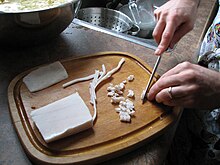Our website is made possible by displaying online advertisements to our visitors.
Please consider supporting us by disabling your ad blocker.
Lardon


A lardon, also spelled lardoon, is a small strip or cube of fatty bacon, or pork fat (usually subcutaneous fat), used in a wide variety of cuisines to flavor savory food and salads. In French cuisine, lardons are also used for larding, by threading them with a needle into meats that are to be braised or roasted. Lardons are not normally smoked, and they are made from pork that has been cured with salt.
In French cuisine, lardons are served hot in salads and salad dressings, as well as on some tartes flambées, stews such as beef bourguignon, quiches such as Quiche Lorraine, in omelettes, with potatoes, and for other dishes such as coq au vin.
The Oxford English Dictionary defines "lardon" as "one of the pieces of bacon or pork which are inserted in meat in the process of larding", giving primacy to that process.[1] According to the Middle English Dictionary, the earliest occurrence of the word is in 1381, in the work Pegge Cook; it advises to insert lardons in cranes and herons.[2]
- ^ "Lardon". Oxford English Dictionary. 1987.
- ^ Lewis, Robert E.; Kurath, Hans (1970). "Lardon". Middle English Dictionary, L.2. Vol. 7. U of Michigan P. p. 657. ISBN 978-0-472-01122-3. Retrieved 26 February 2010.
Previous Page Next Page


